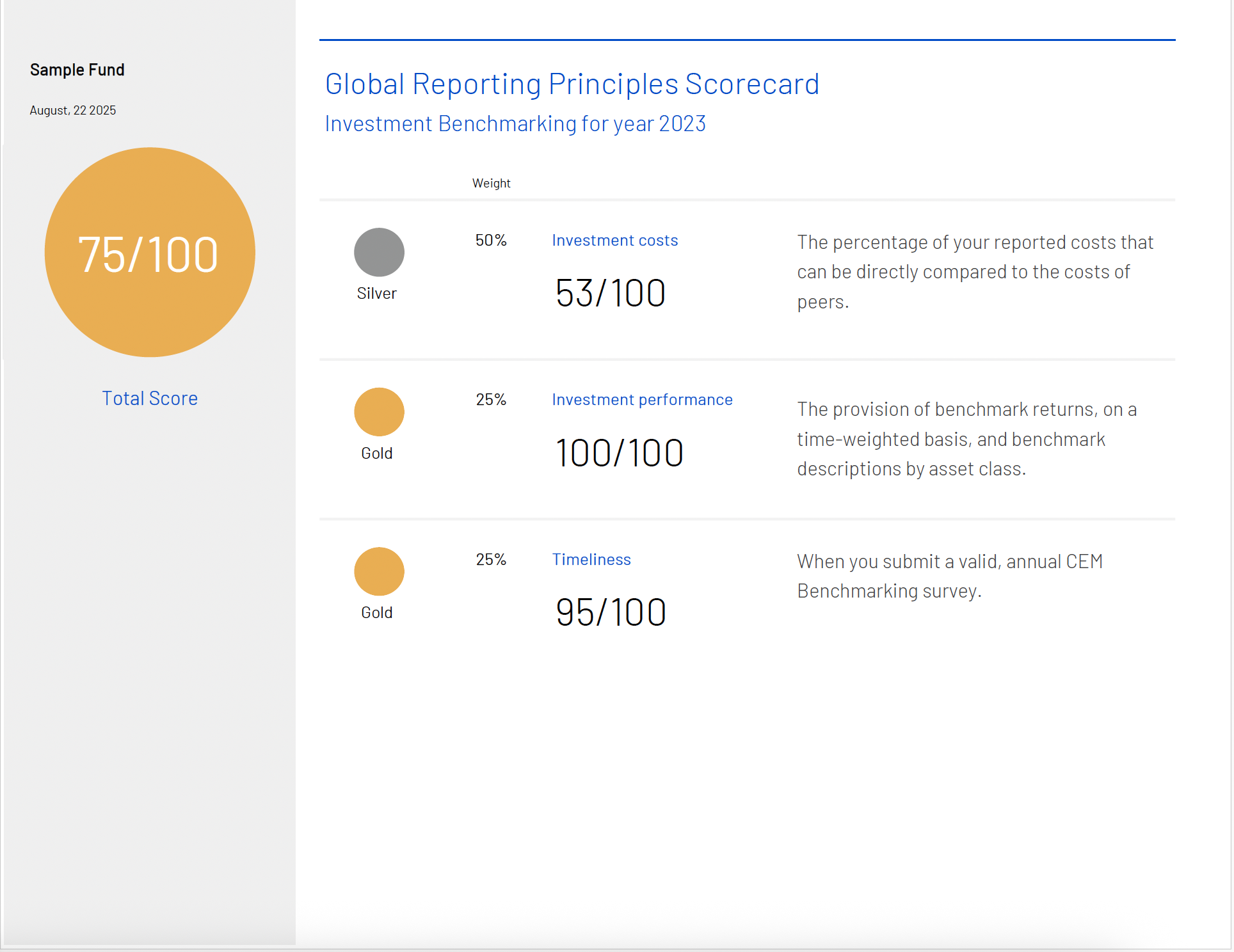CEM's Global Reporting Principles
CEM’s Global Reporting Principles (GRP) are a framework for reporting performance, cost, and timing across geographies. Developed through a multi-year initiative that began in 2022, and shaped in collaboration with seven leading global pension funds, the GRP was formally launched in 2024 to bring clarity and alignment to reporting practices worldwide.
While standards have existed in countries such as Australia, the Netherlands, and the UK, the GRP extend this work by offering a unified approach for the global institutional investment community.
Grounded in transparency and comparability, the Global Reporting Principles provide a shared foundation for meaningful insights and informed decision-making.
GRP Principles Overview
| Investments | Pension Administration | |
|---|---|---|
| 1. Disclose asset value on the appropriate basis for calculating costs. | ||
| 2. Disclose costs that are offset against revenues. | ||
| 3. Look through and include costs incurred in all investment tiers. | ||
| 4. Disclose costs for the same period in which revenues are earned. | ||
| 5. Include indirect taxes that are implicit in the price of a product or service in total costs. | ||
| 6. Include non-recurring costs in total costs. | ||
| 7. Include costs incurred by related parties in total costs. | ||
| 8. Disclose costs in your local currency. | ||
| 9. Disclose investment costs and performance by composite or mandate. | ||
| 10. Disclose if returns are fully gross-of-fees or, if not, disclose what costs are netted from the return. | ||
| 11. Disclose time-weighted returns. | ||
| 12. Use appropriate benchmarks. | ||
| 13. Returns for less than one year must not be annualized. | ||
| 14. Disclose key member service performance metrics. | ||
| 15. Use and explain estimates when alignment to these principles is neither practical nor timely. | ||
| 16. Disclosures should be available for stakeholders in time to fulfill their reporting and decision-making needs. |
Based on these principles, CEM has created a scoring methodology to assess the completeness, comparability and timeliness of all data shared directly with CEM. These scores, with supporting materials, are shared with each CEM benchmarking participant on their GRP Scorecard.
CEM offers distinct GRP scoring for:
- Investment Benchmarking – Beta launched in 2024
- Defined Contribution Benchmarking – Launching in 2026
- Pension Administration Benchmarking – Launching in 2026
GRP Scorecard Methodology for Investment Benchmarking
The GRP score for data reported directly to CEM for Investment Benchmarking is the weighted sum of the scores received on cost reporting, performance reporting and the timeliness of reporting.
Cost reporting – The score for cost reporting assesses the percentage of reported costs that can be directly compared to the costs of peers. Each cost line item is weighted based on the percentage of that cost item to total cost. The weight of the cost score in the total GRP score is 50%.
Performance reporting – The score for performance reporting assesses the complete provision of benchmarks and returns, on a time-weighted basis, and benchmark descriptions by asset class. The weight of the performance score in the total GRP score is 25%.
Timeliness of reporting – The score for timeliness determines if the data was provided in a timely manner, useful for your reporting and peer comparisons. The weight of the timeliness score in the total GRP score is 25%.

Example GRP scorecard for Investment Benchmarking – beta version for year 2024
CEM’s Global Reporting Principles will evolve over time. The release schedule was designed to allow for both feedback from market participants as well as for institutional investors to develop the systems, data, and personnel to action on. The future releases, currently slated for 2026 and later are shared here.
CEM’s benchmarking survey definitions provide detailed guidance on each of these principles.
Guidance on Publishing GRP Scores & Scorecards
Institutional investors who receive GRP scores from CEM may choose to share them publicly in reports or on their websites. The guidelines below outline what information must be included, how the scores may be presented, and the limitations on their use.
1. Who can publish
Institutional investors receiving scores under CEM’s Global Reporting Principles (GRP) may voluntarily publish their GRP scores in public disclosures, including annual reports and websites.
2. Required information
Any disclosure of a GRP score must include:
-
The name of the institutional investor.
-
The calendar year for which the data is scored.
-
The CEM service for which the score is issued.
3. Example language
Institutional investors may use the below formats to publish their scores on their website with the appropriate linking.
Example 1: InvestorABC received a 2023 score of 83 based on CEM’s Global Reporting Principles for their reporting in CEM’s Investment Benchmarking Service. Details on the methodology can be found at www.cembenchmarking.com/GRP.
Example 2 (using footnotes) : InvestorABC received a 2023 score of 83 based on CEM’s Global Reporting Principles for their reporting in CEM’s Investment Benchmarking Service.1
- Details on the methodology can be found at www.cembenchmarking.com/GRP.
4. Restrictions
Institutional investors choosing to publish their scores or scorecards are not permitted to:
-
Provide qualitative interpretation of the scores without CEM’s input.
-
Omit required elements (institution name, year, CEM service, and score).
-
Provide scenario or “what-if” analysis.
For more information or guidance, please contact us at product@cembenchmarking.com.
